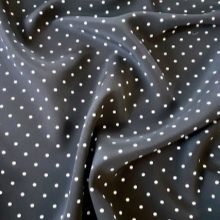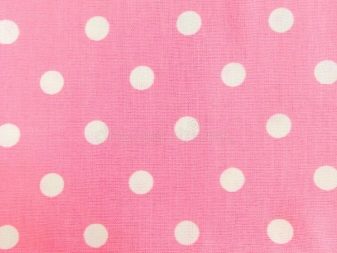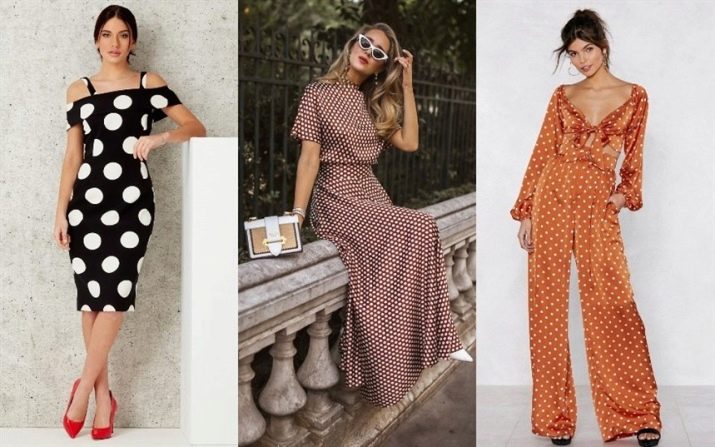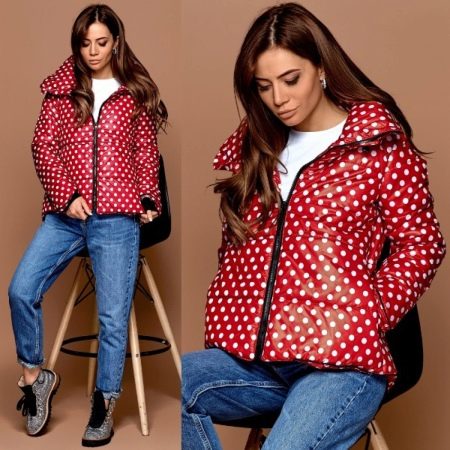All About Polka Dot Fabrics

Polka dots are a popular print on any clothing. It is often chosen by girls, women of different ages, and even men. Therefore, information about fabrics with polka dots will be useful to many. It is worth learning, if not all, then a lot about the color palette and types of fabric.

History
It is difficult to name the exact date of birth of the polka dot fabric. This moment is associated with the end of the 18th - beginning of the 19th centuries, when the technology of printed design appeared on the material.
Perhaps the beginning of the life of such a fabric can be considered the following event: in Switzerland, in the middle of the 18th century, a fabric began to be produced, which was called "Swiss peas". At first, the drawing looked more like a speck, and it was applied to a thin cambric. Later, peas could be of different colors and sizes, and a variety of fabrics appeared.
At the end of the 18th century, peas were already seen in France. Monochromatic outfits began to seem boring to high society, they wanted some kind of variety, and peas came in handy in this case.


Empire-style dresses with a high waist began to be sewn from flowing lightweight fabric with polka dots.
In the 19th century, polka dots are firmly in vogue in different segments of the population. Skirts and blouses of ordinary townspeople were already sewn from such fabric. The same pattern is actively used by flamenco dancers.
But not only the fair sex fell in love with peas. Men also began to use this print, but mostly in their wardrobe there were polka-dot ties. They are popular to this day.

Beginning in the 1920s, polka dot dresses have become firmly established in fashion, and a wide variety of styles and fabrics have been used for this.
But the real peak of popularity of peas came in the 50s of the last century. Polka dot fabric was used for sewing hats, swimwear, dresses, skirts and blouses.
Since then, peas have not gone out of fashion anymore, and fashion designers periodically use them in their collections. In clothing stores, you can definitely find things with such a print. You can also buy fabrics in a wide variety of colors with polka dots in different sizes.

Views
A polka dot pattern can be present on absolutely any fabric. There are no restrictions here, whether it is regular fabric or seamless.
Silk and chiffon, satin and crepe de Chine in large and small peas are very popular. But with the same success, chintz, cotton and linen are used for sewing things with this print. Viscose is no less popular in this sense. Such a pattern is also found on woolen products, but much less often. And even the drape is no exception. Therefore, there is simply no strict division of polka dot fabric into certain types. Here we can only talk about the greater or lesser popularity of this or that type of fabric.



Calico and terry cloth, bike and flannel - all these options can be found with such a pattern, while the size of the peas can vary from very tiny specks to large balls.


Color solutions
Polka dots come in a wide variety of colors. This is, for example:
-
red;
-
blue;
-
brown;
-
blue;
-
green;
-
yellow;
-
beige;
-
pink;
-
gray;
-
orange;
-
lilac;
-
purple.



At the same time, the classic is black and white fabric with a contrasting print. Black fabric will be in white polka dots, and white, on the contrary, in black.
But at the same time, there are many options when, with a harmonious combination, a beautiful fabric is obtained. For example, black, gray, white, beige peas will look equally good on pink fabric. Blue is successfully combined with blue, black, white, gray prints. On green, peas of consonant shades will be appropriate - mint, light green, turquoise.


Yellow, red, brown fabrics with black or white peas are considered popular.


Application
A wide variety of products are sewn from fabric with polka dots. The choice is quite wide.
-
Linens. Often this print can be found on bedding sets. The tone of the canvas, like the peas themselves, can be of a wide variety of colors. Cotton, linen, silk and other fabrics will be used for this purpose.

- Decorative things... This includes cushions, throws, bedspreads. Again, the color gamut can be quite extensive. Fabrics vary. Lampshades made of polka-dot fabric can also be used in the interior; you can often find tablecloths and napkins, towels, sometimes upholstery on furniture.

- Products for newborns... This group includes diapers and blankets for newborns, as well as undershirts, blouses, romper suit. Materials such as cotton, flannel, bike will be used here.

- A wide variety of things can be sewn from fabric with polka dots for the summer.... Among them are dresses of different styles, lengths and colors. In polka dots, both mini-variants of a fitted silhouette and long sundresses look equally good. And here the range of fabrics used is very wide. It can be silk, chiffon, linen, cotton, viscose, polyester. The list of summer clothes doesn't end there. Skirts, blouses, T-shirts, cardigans, swimwear, hats are sewn from such fabrics.

- Children's clothing is especially popular. And in this version, too, you can often find children's dresses, sundresses, T-shirts and panties, bows and knee-highs.

- Outerwear. And although this option is not particularly popular, things from the outerwear series can be found more and more often. And here the spread is significant. These can be raincoats, jackets, coats, and even faux fur. This list also includes knitted hats and felt hats.

- Accessories... Quite a common option. These are scarves and shawls, gloves and umbrellas, bags and backpacks, wallets and cosmetic bags. They can be made from different materials. If scarves and shawls can be made from silk and polyester, then handkerchiefs are made from cotton.Bags and cosmetic bags can often be found made of artificial or natural leather.

- Crafts... Here, fantasy is not limited to anything. And the polka dot material can be used for a wide variety of purposes. From it you can sew a doll outfit, a decorative pillow, a pincushion, upholster a box for all sorts of little things, create a funny soft toy.
As a rule, for such things, scraps of fabric remaining from the sewing of basic things or products that are out of order, but still capable of serving as raw materials for the manufacture of other things, are used.









